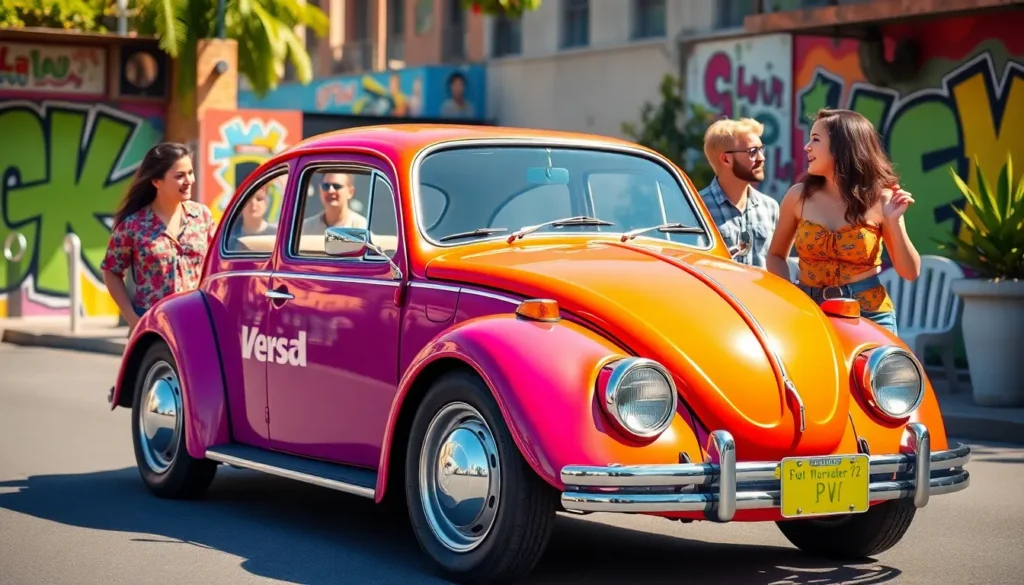The Volkswagen Beetle’s distinctive silhouette has captured hearts and inspired countless design movements for over eight decades. We’ve watched this iconic car evolve from a practical people’s vehicle into a symbol of counterculture rebellion and retro-chic sophistication that continues to influence modern automotive design.
What makes the Beetle’s aesthetic so enduringly appealing? It’s the perfect marriage of form and function wrapped in curves that defy conventional automotive logic. We’re drawn to its friendly face-like front end and that unmistakable rounded profile that looks like it rolled straight out of a cartoon.
From flower power paint jobs to sleek modern interpretations the Beetle’s visual language speaks to something deeper than transportation—it’s about personality self-expression and timeless charm. Whether you’re a classic car enthusiast or simply appreciate good design understanding the Beetle’s aesthetic impact reveals why this little car became one of history’s most recognizable automotive icons.
The Iconic Volkswagen Beetle Design Philosophy
Ferdinand Porsche’s original vision for the Volkswagen Beetle aesthetic centered on creating a car that ordinary people could afford and love. The beetle aesthetic emerged from functional requirements that transformed into emotional design elements over eight decades of production. We can trace the Beetle’s visual appeal to three core principles that shaped its timeless appearance.
Organic curves defined the Beetle’s distinctive silhouette from its earliest prototypes in the 1930s. The rounded hood creates a friendly face that people instantly recognize, while the bubble-shaped cabin provides maximum interior space within a compact footprint. Engineers at Volkswagen discovered that these flowing lines also improved aerodynamics, proving that beautiful design could enhance performance.
Minimalist functionality drove every aesthetic choice throughout the Beetle’s development cycle. Chrome bumpers served dual purposes as both decorative elements and practical protection, while the simple dashboard layout eliminated unnecessary complexity. The beetle aesthetic philosophy rejected ornate styling in favor of honest design that celebrated the car’s mechanical purpose.
Human scale proportions made the Beetle approachable compared to larger American automobiles of the same era. The low height of 59 inches and narrow width of 61 inches created an intimate driving experience that felt personal rather than imposing. Volkswagen designers understood that the beetle aesthetic worked because it matched human proportions, making drivers feel connected to their vehicles.
Color became a crucial expression tool within the Beetle’s design framework. The original gray paint evolved into dozens of vibrant options including Rallye Yellow, Orange, and various shades of blue that allowed owners to personalize their cars. These color choices transformed the utilitarian beetle aesthetic into a canvas for individual creativity while maintaining the core design integrity that made the shape so recognizable.
Timeless Exterior Aesthetics
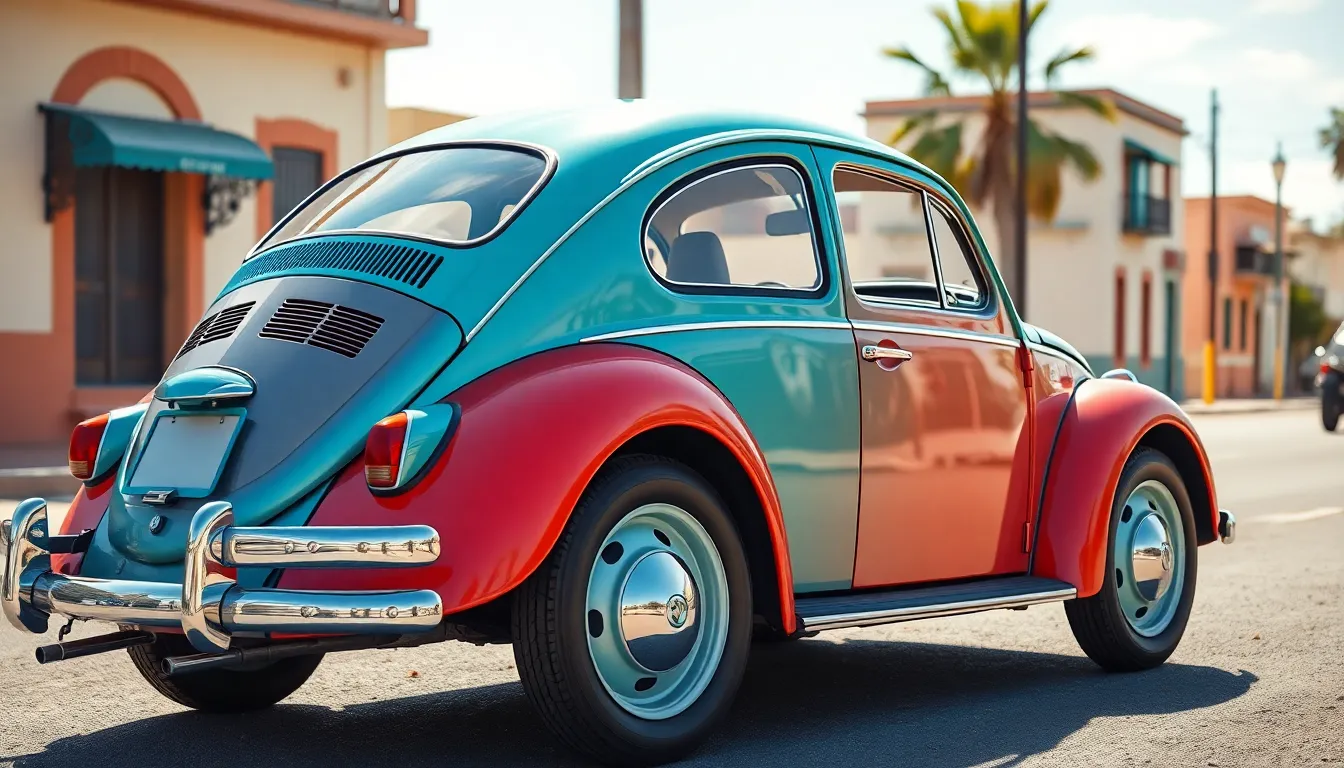
Timeless exterior aesthetics define the Volkswagen Beetle’s enduring visual appeal across multiple generations. Our exploration reveals how exact design elements create an instantly recognizable automotive icon.
Classic Rounded Silhouette
Classic rounded silhouette forms the foundation of Beetle’s unmistakable appearance. Organic curves flow seamlessly from the domed roof to the curved fenders, creating a unified shape that eliminates harsh angles and sharp transitions. Ferdinand Porsche’s original aerodynamic vision emphasized smooth airflow while maintaining structural integrity through the bug-like body profile.
Proportional harmony emerges from the Beetle’s 60-inch height paired with its 61-inch width dimensions. Gentle slopes extend from the windshield to the rear engine compartment, establishing visual continuity that distinguishes it from angular automotive designs. Curved door panels integrate naturally with the rounded wheel arches, reinforcing the cohesive aesthetic philosophy.
Distinctive Front and Rear Design Elements
Distinctive front design elements create the Beetle’s friendly facial character through carefully positioned components. Chrome bumpers wrap around the body’s curves while maintaining functional protection and visual appeal. Headlight placement sits high on the fenders, contributing to the approachable expression that made the Beetle culturally important.
Split rear window design characterized early Beetle models from 1938 to 1952, creating a distinctive visual signature. Engine cooling vents positioned below the rear window serve both functional and aesthetic purposes, allowing heat dissipation while adding textural interest. Taillights integrate into the rear fender curves, maintaining the smooth silhouette while providing essential visibility features.
License plate mounting follows the body’s natural curve, avoiding flat surfaces that would disrupt the organic flow. Running boards extend naturally from the door sills, providing practical stepping surfaces while improving the car’s horizontal visual line.
Color Palette Evolution Through the Decades
Color palette evolution reflects changing automotive trends while preserving Beetle’s design integrity across eight decades. Early production featured conservative colors including black, dark blue, and gray that aligned with 1930s automotive standards.
| Decade | Popular Colors | Notable Additions |
|---|---|---|
| 1950s | Black, Gray, Blue | Two-tone combinations |
| 1960s | Red, Yellow, White | Bright festival colors |
| 1970s | Orange, Green, Brown | Earth tone options |
| 1980s | Metallic finishes | Pearl and candy colors |
| 1990s-2000s | Pastel shades | Retro color revivals |
Bright color options emerged during the 1960s counterculture movement, with yellow, red, and white becoming signature Beetle choices. Volkswagen introduced over 50 color variations throughout production, allowing personal expression while maintaining the iconic shape’s recognition factor.
Special edition colors marked important production milestones, including the final editions that featured unique metallic and pearl finishes. Contemporary Beetle interpretations continue this tradition with modern paint technologies that enhance the classic aesthetic while meeting current automotive standards.
Interior Design and Cabin Aesthetics
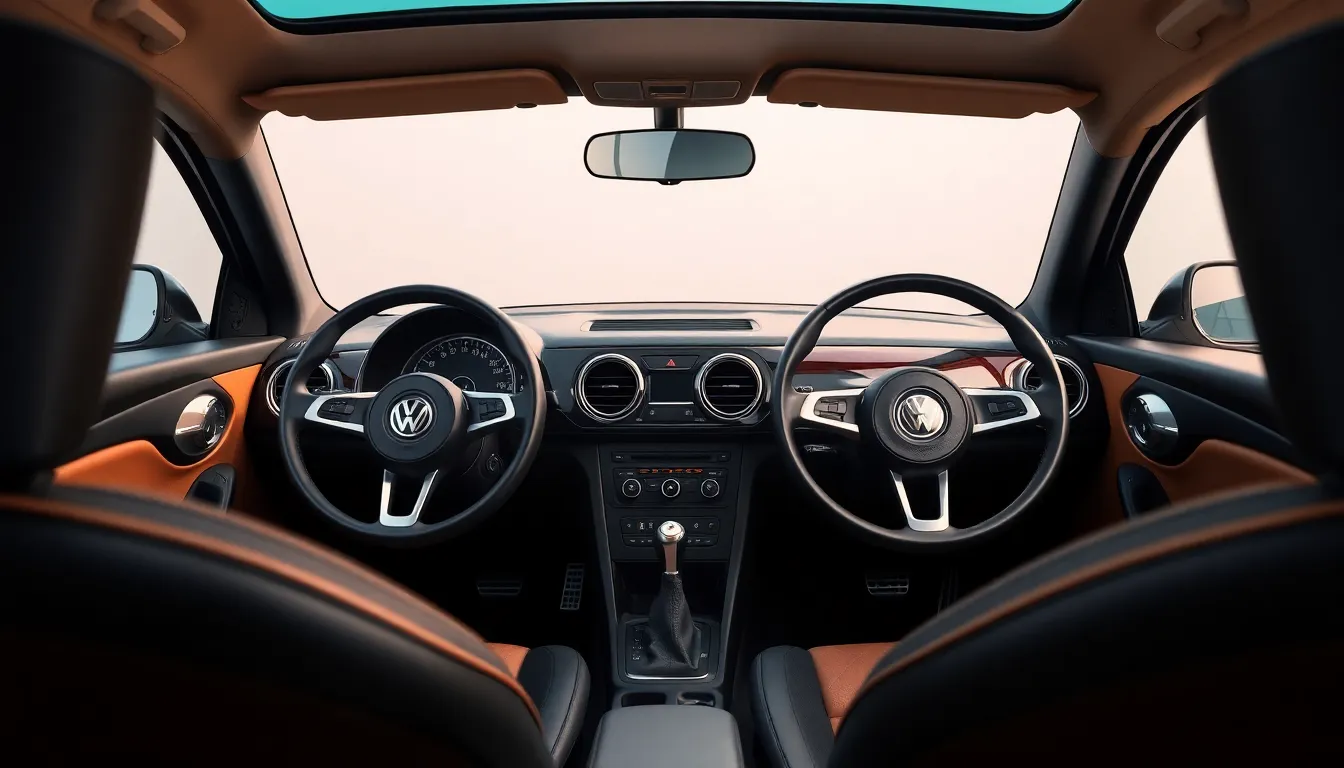
The Beetle’s interior design philosophy mirrors its exterior approach with clean lines and purposeful elements that eliminate unnecessary complexity. We find the same organic curves and human scale proportions carried through every cabin detail.
Minimalist Dashboard Layout
Minimalist dashboard design defines the Beetle’s interior aesthetic through strategic placement of essential controls and gauges. The dashboard features a horizontal layout that extends the car’s width while maintaining visual simplicity through grouped circular elements. We observe three primary zones: the speedometer positioned directly in front of the driver, climate controls centered for easy access, and radio placement integrated seamlessly into the overall design.
Chrome accents highlight key functional areas without overwhelming the clean aesthetic, including gear shift bezels, door handles, and instrument trim rings. The steering wheel maintains the same circular theme found throughout the vehicle, with thin spokes that don’t obstruct gauge visibility. Central air vents use round openings that complement the car’s organic design language while providing efficient airflow distribution.
Storage answers integrate naturally into the dashboard structure, with a glove compartment that opens smoothly and door pockets positioned for intuitive use. The simplicity eliminates visual clutter while ensuring every element serves a clear purpose in the driving experience.
Retro Modern Material Choices
Retro modern materials blend vintage textures with contemporary durability to create an authentic yet updated interior experience. We select vinyl upholstery in period appropriate colors including black, white, and saddle brown that reference classic Beetle interiors while offering modern stain resistance. Fabric seat inserts feature geometric patterns or solid colors that complement the exterior paint choices without competing for attention.
Dashboard materials combine painted metal surfaces with textured vinyl that mimics the original design aesthetic. Chrome bezels surround gauges and switches, providing the metallic accents that defined 1960s automotive interiors. We incorporate brushed aluminum trim on modern iterations to bridge vintage styling with contemporary expectations for premium materials.
Floor coverings use rubber mats with distinctive patterns that echo the Beetle’s playful character while providing practical weather protection. Door panels feature two tone combinations with upper vinyl sections and lower painted metal areas that create visual interest through material contrast. The headliner uses woven fabric in neutral tones that unify the cabin space while maintaining the car’s approachable personality through soft textures and warm colors.
Aesthetic Evolution Across Generations
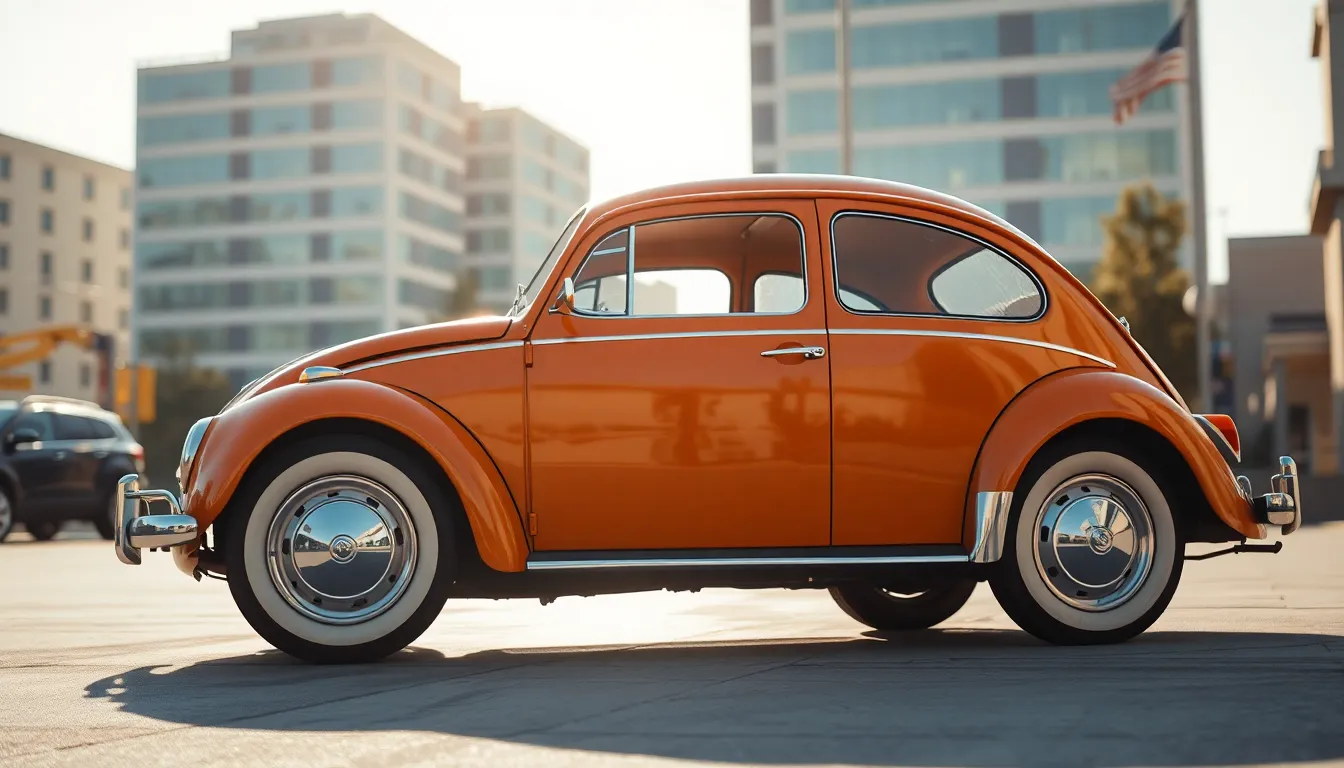
The Volkswagen Beetle’s aesthetic journey spans three distinct eras, each reflecting the cultural and technological zeitgeist of its time. Each generation maintained the core beetle aesthetic while adapting to contemporary design trends and manufacturing capabilities.
Original Beetle Classic Appeal
Classic Beetle design established the foundational aesthetic elements that define volkswagen beetle identity across all generations. The original 1938 design featured hand-formed curves, chrome accents, and exposed bumpers that created an honest relationship between form and function. Split rear windows from 1938-1952 divided the vehicle’s rear glass into two distinct sections, creating a distinctive visual signature that collectors prize today.
Chrome elements dominated the original beetle’s exterior detailing through bumpers, window trim, and door handles that reflected light and added premium touches to the affordable vehicle. Running boards extended along the vehicle’s lower sections, providing both functional step surfaces and visual weight that grounded the rounded body. Fender-mounted turn signals appeared as separate chrome housings that punctuated the smooth body panels with purposeful design elements.
Paint options remained conservative through the 1950s with colors like black, gray, and beige that emphasized the vehicle’s practical nature over expressive styling. The original beetle’s proportions created a 1:1:1 relationship between height, width, and length that produced balanced visual harmony from every viewing angle.
New Beetle’s Modern Interpretation
Modern reinterpretation arrived in 1997 when Volkswagen launched the New Beetle with contemporary manufacturing techniques applied to classic beetle proportions. The New Beetle retained the rounded profile while incorporating modern safety requirements through integrated bumpers, larger glass areas, and streamlined body panels. Front-wheel drive architecture allowed designers to lower the vehicle’s stance and create a more aggressive wheel-to-body relationship.
Interior design embraced retro modern elements through a single flower vase mounted in the dashboard, circular air vents, and body-colored interior panels that connected the cabin aesthetic to the exterior paint scheme. Technology integration included modern amenities like air conditioning, power windows, and stereo systems while maintaining the minimalist dashboard philosophy of the original design.
Color palette expanded significantly with options like Cyber Green, Reflex Yellow, and Tornado Red that celebrated the 1960s counterculture movement’s vibrant expression. Special editions featured unique color combinations, custom wheels, and interior treatments that allowed owners to personalize their vehicles while preserving the core beetle aesthetic elements.
Contemporary Beetle’s Refined Style
Contemporary design evolution culminated in the final generation Beetle (2011-2019) that refined the aesthetic formula through sophisticated proportions and premium materials. The final beetle featured a lower, wider stance that emphasized performance over the friendly character of previous generations. LED lighting technology replaced traditional bulbs in headlights and taillights, creating modern light signatures within classic round housings.
Premium interior materials included soft-touch surfaces, ambient lighting, and available leather seating that elevated the cabin experience beyond previous beetle generations. Digital instrument displays replaced analog gauges while maintaining circular design elements that honored the original beetle’s aesthetic philosophy.
Limited production runs featured special edition treatments like the Denim Beetle with unique blue fabric seats and exterior details that celebrated the vehicle’s cultural heritage. The Final Edition models included exclusive color options, premium wheels, and commemorative badging that marked the end of the beetle’s 81-year production history while celebrating its enduring aesthetic legacy.
Cultural Impact on Automotive Aesthetics
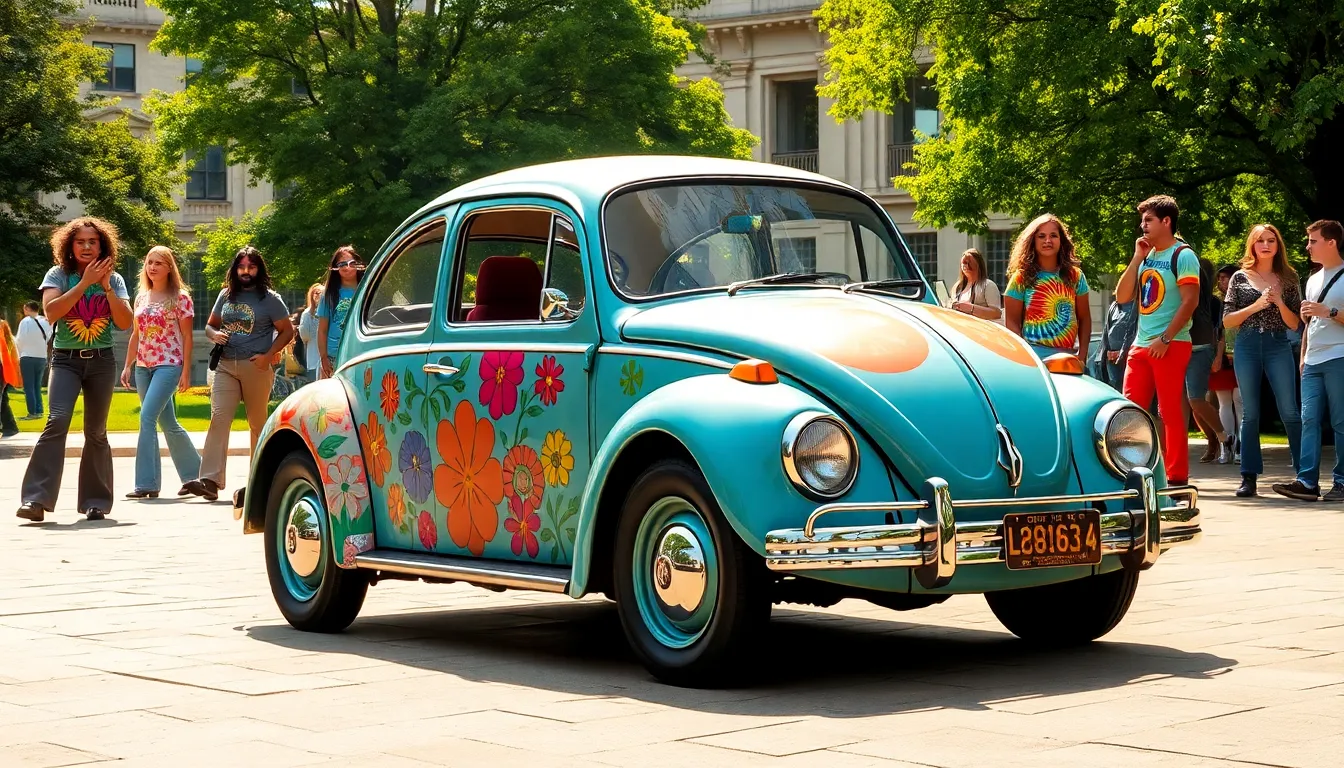
Cultural movements shaped the Volkswagen Beetle aesthetic more profoundly than any other automotive design in history. We observe how the vehicle transformed from practical German engineering into a canvas for global self-expression across eight decades.
Counterculture Movement and Design Philosophy
Beetle aesthetics became synonymous with rebellion during the 1960s counterculture revolution. Young Americans embraced the car’s unpretentious design as an alternative to Detroit’s chrome-heavy luxury vehicles. We find that the Beetle’s rounded forms and honest construction challenged traditional automotive status symbols.
Cultural Expression Elements:
- Hand-painted flowers and peace symbols adorned exterior surfaces
- Bright orange, lime green, and electric blue colors replaced conservative tones
- Custom interior modifications reflected personal artistic visions
- Anti-establishment messaging transformed vehicles into mobile manifestos
Global Design Influence Patterns
Beetle design principles influenced automotive aesthetics across multiple manufacturers and decades. We trace how the car’s organic curves inspired everything from the BMW Mini Cooper’s revival to modern electric vehicle designs. The Beetle demonstrated that emotional connection trumped purely functional automotive design.
Manufacturers adopted three key Beetle aesthetic principles:
| Design Element | Cultural Impact | Modern Applications |
|---|---|---|
| Rounded silhouettes | Friendly, approachable vehicles | Electric cars, crossover SUVs |
| Human-scale proportions | Personal mobility focus | Urban transportation answers |
| Color personalization | Individual expression priority | Custom paint programs |
Hollywood and Media Representation
Cinema elevated Beetle aesthetics beyond transportation into cultural iconography. Herbie films showcased how personality could be embedded in automotive design through visual storytelling. We recognize that media representation cemented the Beetle’s friendly character in popular consciousness.
The car’s photogenic qualities made it a preferred choice for:
- Romance films emphasizing authenticity over luxury
- Adventure movies requiring reliable, relatable transportation
- Documentary footage capturing grassroots cultural movements
- Advertising campaigns promoting democratic design values
Youth Culture and Personalization Trends
College campuses became laboratories for Beetle aesthetic experimentation during the 1970s. Students treated their vehicles as three-dimensional canvases for artistic expression and political messaging. We observe how this personalization culture influenced later automotive customization markets.
Beetle owners pioneered aesthetic modifications including:
- Convertible roof conversions for open-air experiences
- Surfboard racks creating California beach culture connections
- Festival stickers documenting musical and cultural journeys
- Interior tapestries and cushions reflecting bohemian aesthetics
Environmental Movement Symbolism
Beetle aesthetics aligned perfectly with emerging environmental consciousness during the 1970s. The car’s modest size and unpretentious design embodied values opposing excess consumption. We note how the Beetle’s visual simplicity communicated environmental responsibility before eco-friendly became mainstream.
Environmental advocates appreciated the Beetle’s honest design language that avoided wasteful ornamentation. This aesthetic philosophy influenced later sustainable design movements across industries beyond automotive manufacturing.
Customization and Personalization Trends

Beetle enthusiasts transform their vehicles into unique expressions of personality through diverse modification approaches. Modern customization culture embraces both contemporary upgrades and authentic restoration techniques that celebrate the vehicle’s heritage.
Popular Aesthetic Modifications
Paint and Graphics
Custom paint schemes dominate modern Beetle personalization with owners selecting vibrant color combinations that reflect individual style. Matte black finishes create dramatic contrasts against chrome accents, while candy apple red and electric blue generate eye-catching street presence. Graphics packages include racing stripes, geometric patterns, and artistic murals that transform the Beetle’s rounded surfaces into mobile canvases.
Wheel and Tire Combinations
Period-correct steel wheels with whitewall tires maintain authentic 1960s aesthetics, measuring 15 inches in diameter with 4-inch whitewall sections. Modern interpretations feature 17-inch alloy wheels in chrome or black finishes that preserve the Beetle’s proportional balance. Performance enthusiasts install wider tire profiles (195/65R15) that enhance handling while maintaining the vehicle’s classic stance.
Exterior Hardware Updates
Chrome bumper restoration involves professional replating processes costing $400-800 per bumper to achieve mirror finishes. LED headlight conversions maintain the original round housing dimensions while providing 3,000-lumen output for improved visibility. Custom grille modifications include mesh inserts, badge relocations, and air intake enhancements that complement the Beetle’s front-end character.
Interior Personalization Elements
Dashboard modifications incorporate modern gauges within vintage-style bezels, maintaining the original horizontal layout while adding contemporary functionality. Seat upholstery options range from authentic vinyl patterns to modern leather treatments in classic color combinations like black and white or tan and brown. Custom steering wheels feature smaller 13-inch diameters with wood grain or chrome finishes that enhance the driver connection experience.
Vintage Restoration Appeal
Authentic Color Matching
Original paint codes guide restoration projects with colors like L87 Pastel White, L41 Black, and L90B Pearl White representing the most sought-after finishes. Professional restoration shops use spectrophotometer analysis to match factory colors within 2% accuracy, ensuring authentic appearances. Period-correct two-stage paint processes recreate the original factory finish depth and gloss characteristics.
Original Equipment Sourcing
Authentic parts markets supply NOS (New Old Stock) components including chrome trim pieces, rubber seals, and mechanical components that maintain factory specifications. Specialist suppliers offer reproduction parts manufactured to original tolerances, with items like door handles, window mechanisms, and light assemblies meeting OEM quality standards. Complete restoration projects typically require 200-300 individual components to achieve concours-level authenticity.
Period-Appropriate Modifications
Restoration enthusiasts research exact model years to ensure modifications align with historical accuracy, including appropriate wheel styles, trim levels, and optional equipment packages. California-style modifications from the 1960s include lowered suspensions (2-3 inches), custom paint schemes, and period accessories that reflect the era’s customization trends. European restoration approaches emphasize mechanical authenticity with emphasis on original carburetor setups, electrical systems, and suspension components.
Documentation and Provenance
Authentic restorations require extensive documentation including original sales receipts, maintenance records, and photographic evidence of factory configurations. Numbers-matching vehicles command premium values, with original engine and transmission combinations verified through VIN decoding and factory records. Restoration projects document each phase through photography, creating portfolios that enhance vehicle value and historical significance.
Conclusion
The Volkswagen Beetle’s aesthetic legacy extends far beyond its 81-year production run. We’ve witnessed how this remarkable vehicle transformed from Ferdinand Porsche’s vision of affordable transportation into a global symbol of individuality and creative expression.
What makes the Beetle truly exceptional isn’t just its timeless design philosophy of organic curves and minimalist functionality. It’s how this aesthetic became a canvas for personal expression across generations while maintaining its core visual identity through every evolution.
Today’s enthusiasts continue to celebrate the Beetle’s aesthetic through restoration projects and creative customizations. Whether preserving original authenticity or adding personal touches the Beetle remains a testament to how thoughtful design can transcend its original purpose.
The Beetle’s visual language continues influencing modern automotive design proving that authentic aesthetic principles never go out of style. Its rounded forms and honest construction created a template for approachable design that resonates across cultures and decades.
Frequently Asked Questions
What made the Volkswagen Beetle’s design so iconic?
The Beetle’s design became iconic through its unique combination of organic curves, minimalist functionality, and human-scale proportions. Ferdinand Porsche’s vision created a friendly, approachable vehicle with a rounded silhouette that eliminated harsh angles. The distinctive front end, chrome accents, and vibrant color options allowed for personal expression while maintaining timeless appeal that transcended mere transportation.
How did the Beetle evolve across different generations?
The Beetle evolved through three distinct generations spanning 81 years. The original (1938) featured hand-formed curves and chrome details. The New Beetle (1997) modernized classic proportions with contemporary safety features and vibrant colors celebrating 1960s counterculture. The final generation (2011-2019) refined the design with premium materials and advanced technology while honoring its cultural heritage.
Why did the Beetle become a symbol of counterculture in the 1960s?
During the 1960s, the Beetle’s unpretentious design and honest construction challenged traditional automotive status symbols. Young Americans embraced its modest aesthetic over luxury vehicles, transforming it into a canvas for self-expression through hand-painted flowers, vibrant colors, and custom modifications. This represented rebellion against excess consumption and aligned with environmental consciousness and anti-establishment values.
What are the key design principles that defined the Beetle’s aesthetic?
The Beetle’s design was built on three core principles: organic curves that enhanced both aesthetics and aerodynamics, minimalist functionality that prioritized honest design over ornate styling, and human-scale proportions that made the vehicle approachable and friendly. These principles created a harmonious relationship between form and function that resonated with people across generations.
How has Beetle customization influenced automotive culture?
Beetle customization became a significant cultural movement, with enthusiasts transforming their vehicles through custom paint schemes, wheel combinations, interior modifications, and artistic expressions. This personalization trend influenced broader automotive customization culture and inspired similar approaches across different manufacturers. The Beetle’s design served as a perfect canvas for individual creativity and self-expression.
What impact did the Beetle have on modern automotive design?
The Beetle’s design philosophy influenced numerous modern vehicles, including the BMW Mini Cooper and various electric cars. Its emphasis on honest construction, functional beauty, and environmental responsibility shaped sustainable design movements beyond automotive. The rounded forms and minimalist approach challenged industry norms and established new standards for accessible, expressive vehicle design.
Why is vintage Beetle restoration so popular among enthusiasts?
Vintage Beetle restoration appeals to enthusiasts because it preserves automotive history while allowing personal connection to an iconic design. Authentic restorations require careful attention to original color matching, period-appropriate parts, and historical accuracy. These projects command premium values and maintain the vehicle’s cultural significance while providing hands-on engagement with timeless design principles.
How did color choices contribute to the Beetle’s personality?
Color played a crucial role in the Beetle’s appeal, evolving from conservative early options to vibrant 1960s hues that celebrated counterculture expression. The wide palette allowed owners to personalize their vehicles while maintaining the iconic shape’s integrity. Special edition colors and modern interpretations continued this legacy, showcasing the Beetle’s adaptability and lasting visual impact.

